Simulation of the Irradiation Cascade Effect of 6H-SiC Based on Molecular Dynamics Principles
Abstract
1. Introduction
2. Modelling of 6H-SiC and Experimental Design
3. Results and Discussion
3.1. Evolution of PKA Energy and Frenkel Pairs over Time
3.2. Spatial Distribution of Defects
3.3. Cluster Analysis
4. Conclusions
Author Contributions
Funding
Data Availability Statement
Conflicts of Interest
References
- Ali, Z.; Ali, K.; Hussain, B.; Maqsood, S.; Iqbal, I. Towards the enhanced efficiency of ultrathin Sb2Se3 based solar cell with cubic silicon carbide (3C–SiC) buffer layer. Opt. Mater. 2022, 128, 112358. [Google Scholar] [CrossRef]
- Sameera, J.N.; Islam, M.A.; Islam, S.; Hossain, T.; Sobayel, M.; Akhtaruzzaman, M.; Amin, N.; Rashid, M.J. Cubic Silicon Carbide (3C–SiC) as a buffer layer for high efficiency and highly stable CdTe solar cell. Opt. Mater. 2022, 123, 111911. [Google Scholar] [CrossRef]
- Yang, F.; Tang, X.; Wei, X.; Sang, L.; Liu, R.; Bai, S.; Peng, T.; Zhao, G.; Yang, P.; Yang, T.; et al. Demonstrations of high voltage SiC materials, devices and applications in the solid state transformer. J. Cryst. Growth 2023, 604, 127059. [Google Scholar] [CrossRef]
- Kodolitsch, E.; Sodan, V.; Krieger, M.; Weber, H.B.; Tsavdaris, N. Impact of crystalline defects in 4H-SiC epitaxial layers on the electrical characteristics and blocking capability of SiC power devices. Mater. Res. Express 2022, 9, 125901. [Google Scholar] [CrossRef]
- Erlekampf, J.; Rommel, M.; Rosshirt-Lilla, K.; Kallinger, B.; Berwian, P.; Friedrich, J.; Erlbacher, T. Lifetime limiting defects in 4H-SiC epitaxial layers: The influence of substrate originated defects. J. Cryst. Growth 2021, 560–561, 126033. [Google Scholar] [CrossRef]
- Rashid, M.H.; Koel, A.; Rang, T.; Nasir, N.; Mehmood, H.; Cheema, S. Modeling and Simulations of 4H-SiC/6H-SiC/4H-SiC Single Quantum-Well Light Emitting Diode Using Diffusion Bonding Technique. Micromachines 2021, 12, 1499. [Google Scholar] [CrossRef] [PubMed]
- Liu, Q.; Zhou, D.; Cai, X.; Qi, M.; Xu, W.; Chen, D.; Ren, F.; Zhang, R.; Zheng, Y.; Lu, H. Effect of very high-fluence proton radiation on 6H-SiC photoconductive proton detectors. IEEE Electron Device Lett. 2019, 40, 1929–1932. [Google Scholar] [CrossRef]
- Samolyuk, G.D.; Osetsky, Y.; Stoller, R.E. Molecular dynamics modeling of atomic displacement cascades in 3C–SiC: Comparison of interatomic potentials. J. Nucl. Mater. 2015, 465, 83–88. [Google Scholar] [CrossRef]
- Aradi, E.; Lewis-Fell, J.; Greaves, G.; Donnelly, S.; Hinks, J. Low-temperature investigations of ion-induced amorphisation in silicon carbide nanowhiskers under helium irradiation. Appl. Surf. Sci. 2020, 501, 143969. [Google Scholar] [CrossRef]
- Backman, M.; Toulemonde, M.; Pakarinen, O.H.; Juslin, N.; Djurabekova, F.; Nordlund, K.; Debelle, A.; Weber, W.J. Molecular dynamics simulations of swift heavy ion induced defect recovery in SiC. Comput. Mater. Sci. 2013, 67, 261–265. [Google Scholar] [CrossRef]
- Malerba, L.; Perlado, J.M. Basic mechanisms of atomic displacement production in cubic silicon carbide: A molecular dynamics study. Phys. Rev. B 2002, 65, 45202. [Google Scholar] [CrossRef]
- Zarkadoula, E.; Samolyuk, G.; Zhang, Y.; Weber, W.J. Electronic stopping in molecular dynamics simulations of cascades in 3C–SiC. J. Nucl. Mater. 2020, 540, 152371. [Google Scholar] [CrossRef]
- Flessa, A.; Ntemou, E.; Kokkoris, M.; Liarokapis, E.; Gloginjić, M.; Petrović, S.; Erich, M.; Fazinić, S.; Karlušić, M.; Tomić, K. Raman mapping of 4-MeV C and Si channeling implantation of 6H-SiC. J. Raman Spectrosc. 2019, 50, 1186–1196. [Google Scholar] [CrossRef]
- Gloginjić, M.; Erich, M.; Kokkoris, M.; Liarokapis, E.; Fazinić, S.; Karlušić, M.; Luketić, K.T.; Petrović, S. The quantitative 6H-SiC crystal damage depth profiling. J. Nucl. Mater. 2021, 555, 153143. [Google Scholar] [CrossRef]
- Wang, T.; Yang, Z.; Li, B.; Xu, S.; Liao, Q.; Ge, F.; Zhang, T.; Li, J. Lattice defects and exfoliation efficiency of 6H-SiC via H2+ implantation at elevated temperature. Materials 2020, 13, 5723. [Google Scholar] [CrossRef] [PubMed]
- Ali, A.A.; Kumar, J.; Ramakrishnan, V.; Asokan, K. Raman spectroscopic study of He ion implanted 4H and 6H-SiC. Mater. Lett. 2018, 213, 208–210. [Google Scholar] [CrossRef]
- Kamalakkannan, K.; Rajaraman, R.; Sundaravel, B.; Amarendra, G.; Sivaji, K. Effect of nitrogen ion implantation in semi insulating 6H-SiC and recrystallization probed by Raman scattering. Nucl. Instrum. Methods Phys. Res. Sect. B Beam Interact. Mater. At. 2019, 457, 24–29. [Google Scholar] [CrossRef]
- Madito, M.J.; Hlatshwayo, T.T.; Mtshali, C.B. Chemical disorder of a-SiC layer induced in 6H-SiC by Cs and I ions co-implantation: Raman spectroscopy analysis. Appl. Surf. Sci. 2021, 538, 148099. [Google Scholar] [CrossRef]
- Casady, J.; Johnson, R.W. Status of silicon carbide (SiC) as a wide-bandgap semiconductor for high-temperature applications: A review. Solid-State Electron. 1996, 39, 1409–1422. [Google Scholar] [CrossRef]
- Jiang, W.; Weber, W.; Thevuthasan, S.; McCready, D. Displacement energy measurements for ion-irradiated 6H–SiC. Nucl. Instrum. Methods Phys. Res. Sect. B Beam Interact. Mater. At. 1999, 148, 557–561. [Google Scholar] [CrossRef]
- Devanathan, R.; De La Rubia, T.D.; Weber, W.J. Displacement threshold energies in β-SiC. J. Nucl. Mater. 1998, 253, 47–52. [Google Scholar] [CrossRef]
- Liu, C.; Szlufarska, I. Distribution of defect clusters in the primary damage of ion irradiated 3C-SiC. J. Nucl. Mater. 2018, 509, 392–400. [Google Scholar] [CrossRef]
- Liao, W.; He, C.; He, H. Molecular dynamics simulation of displacement damage in 6H-SiC. Radiat. Eff. Defects Solids 2019, 174, 729–740. [Google Scholar] [CrossRef]
- Stillinger, F.H.; Weber, T.A. Fluorination of the dimerized Si (100) surface studied by molecular-dynamics simulation. Phys. Rev. Lett. 1989, 62, 2144. [Google Scholar] [CrossRef] [PubMed]
- Gao, F.; Weber, W.J. Atomic-scale simulation of 50 keV Si displacement cascades in β-SiC. Phys. Rev. B 2000, 63, 811–820. [Google Scholar] [CrossRef]
- Devanathan, R.; Gao, F.; Weber, W.J. Atomic scale simulation of defect production in irradiated 3C-SiC. Appl. Phys. 2001, 90, 2303–2309. [Google Scholar] [CrossRef]
- Pinzon, R.; Urbassek, H.M. Implantation and damage under oblique low-energy Si self-bombardment. Phys. Rev. B 2001, 63, 195319. [Google Scholar] [CrossRef]
- Ziegler, J.F.; Ziegler, M.D.; Biersack, J.P. SRIM—The stopping and range of ions in matter (2010). Nucl. Instrum. Methods Phys. Res. Sect. B Beam Interact. Mater. At. 2010, 268, 1818–1823. [Google Scholar] [CrossRef]
- Tersoff, J. Modeling solid-state chemistry: Interatomic potentials for multicomponent systems. Phys. Rev. B 1989, 39, 5566. [Google Scholar] [CrossRef]
- Tersoff, J. Carbon defects and defect reactions in silicon. Phys. Rev. Lett. 1990, 64, 1757. [Google Scholar] [CrossRef]
- Erhart, P.; Albe, K. Analytical potential for atomistic simulations of silicon, carbon, and silicon carbide. Phys. Rev. B 2005, 71, 35211. [Google Scholar] [CrossRef]
- Norgett, M.J.; Robinson, M.T.; Torrens, I.M. A proposed method of calculating displacement dose rates. Nucl. Eng. Des. 1975, 33, 50–54. [Google Scholar] [CrossRef]
- Kinchin, G.H.; Pease, R.S. The displacement of atoms in solids by radiation. Rep. Prog. Phys. 1955, 18, 1. [Google Scholar] [CrossRef]
- Xue, H.; Zarkadoula, E.; Sachan, R.; Zhang, Y.; Trautmann, C.; Weber, W.J. Synergistically-enhanced ion track formation in pre-damaged strontium titanate by energetic heavy ions. Acta Mater. 2018, 150, 351–359. [Google Scholar] [CrossRef]
- Jortner, J. Cluster size effects. Z. Phys. D At. Mol. Clust. 1992, 24, 247–275. [Google Scholar] [CrossRef]
- Zhou, Y.; Chen, B.; He, H.; Li, B.; Wang, X. Displacement cascades in monocrystalline silicon: Effects of temperature, strain, and PKA energy. Nucl. Technol. 2020, 206, 32–39. [Google Scholar] [CrossRef]
- He, H.; He, C.; Zhang, J.; Liao, W.; Zang, H.; Li, Y.; Liu, W. Primary damage of 10 keV Ga PKA in bulk GaN material under different temperatures. Nucl. Eng. Technol. 2020, 52, 1537–1544. [Google Scholar] [CrossRef]
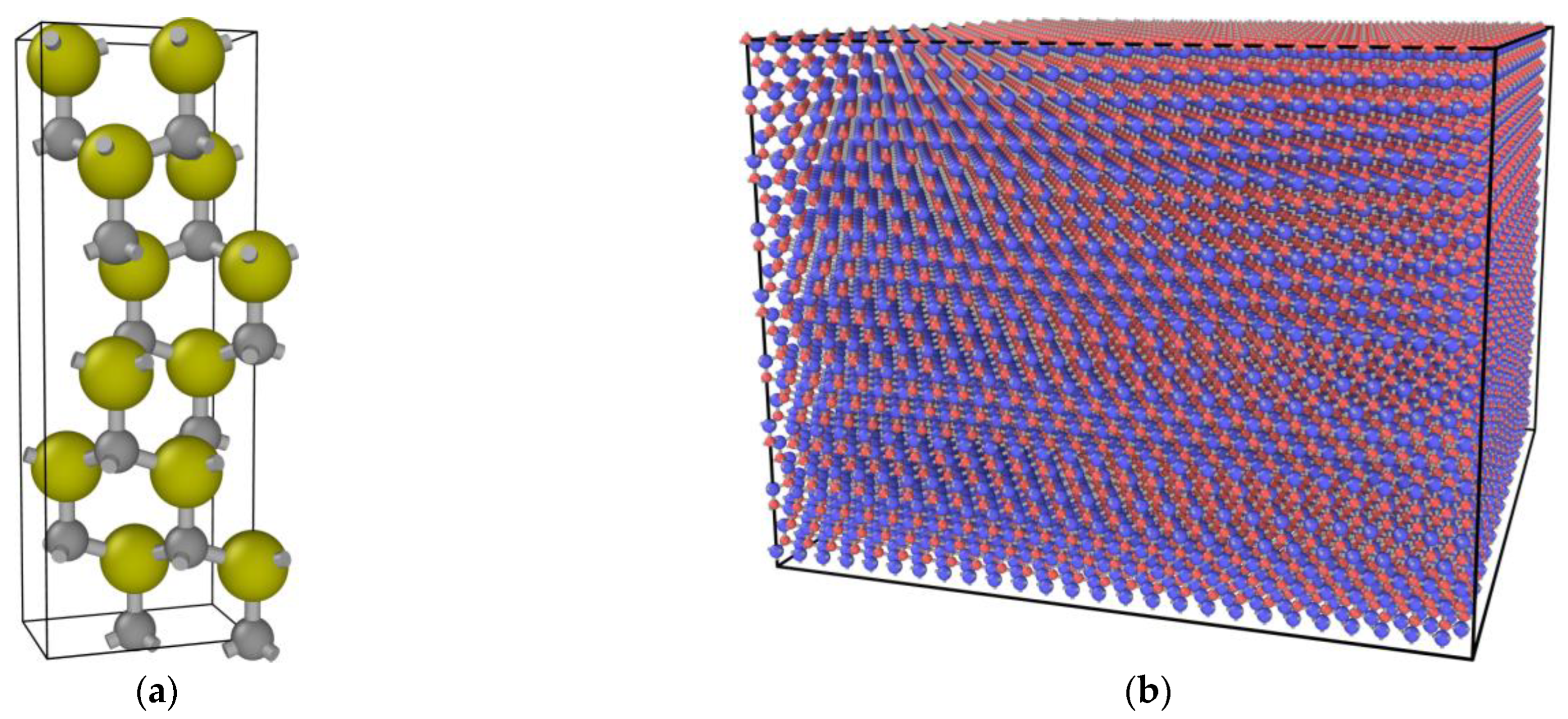
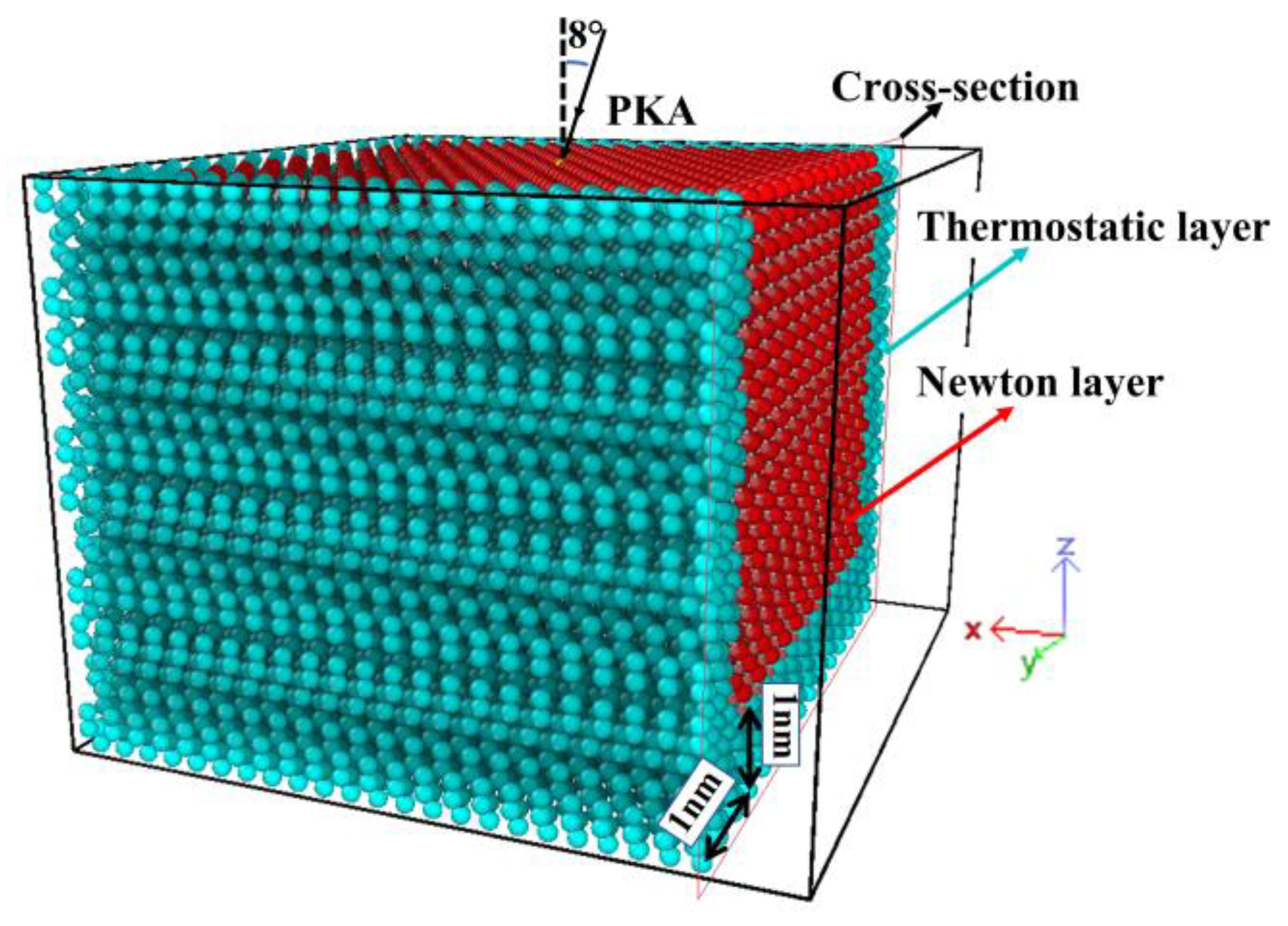
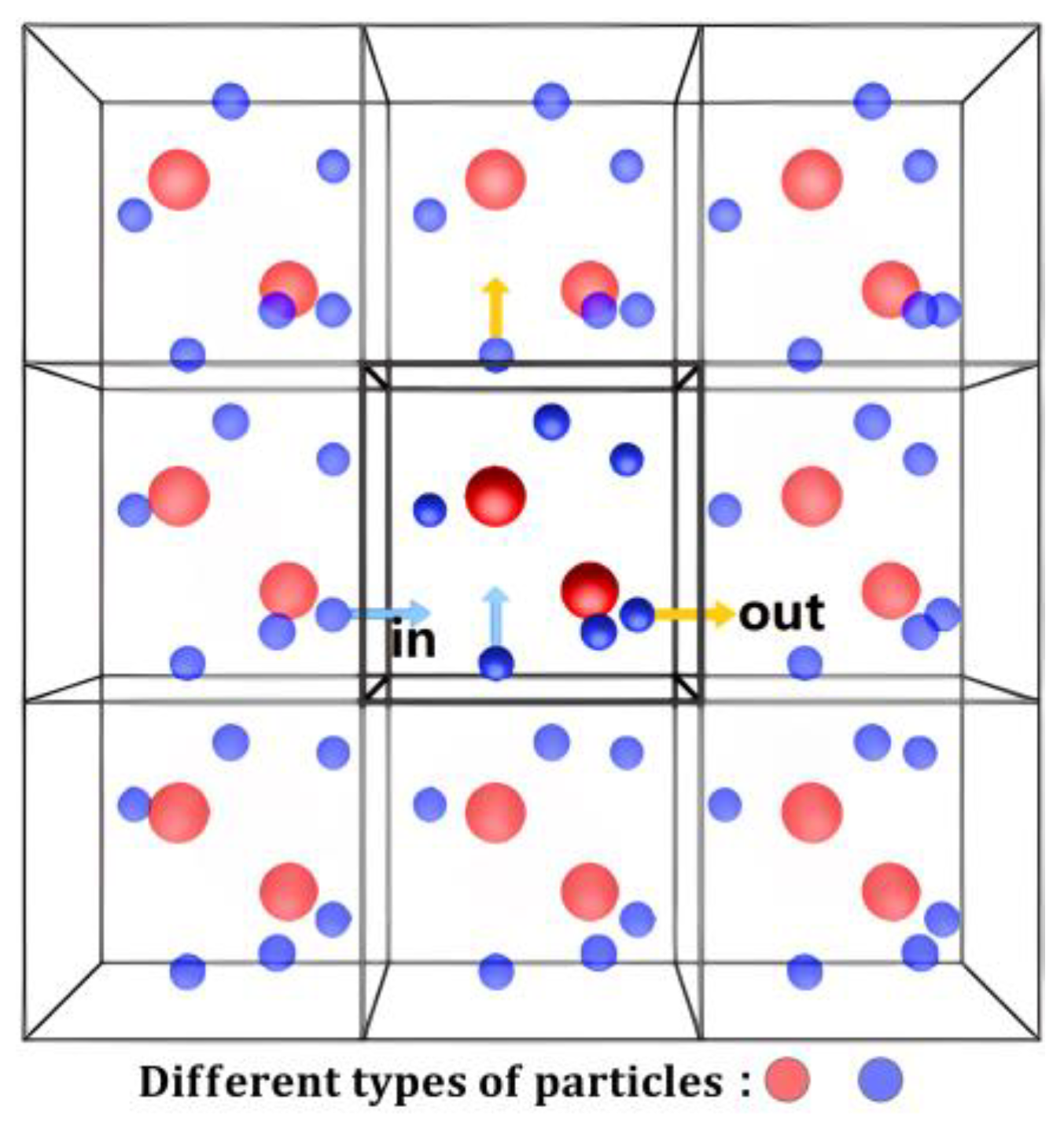
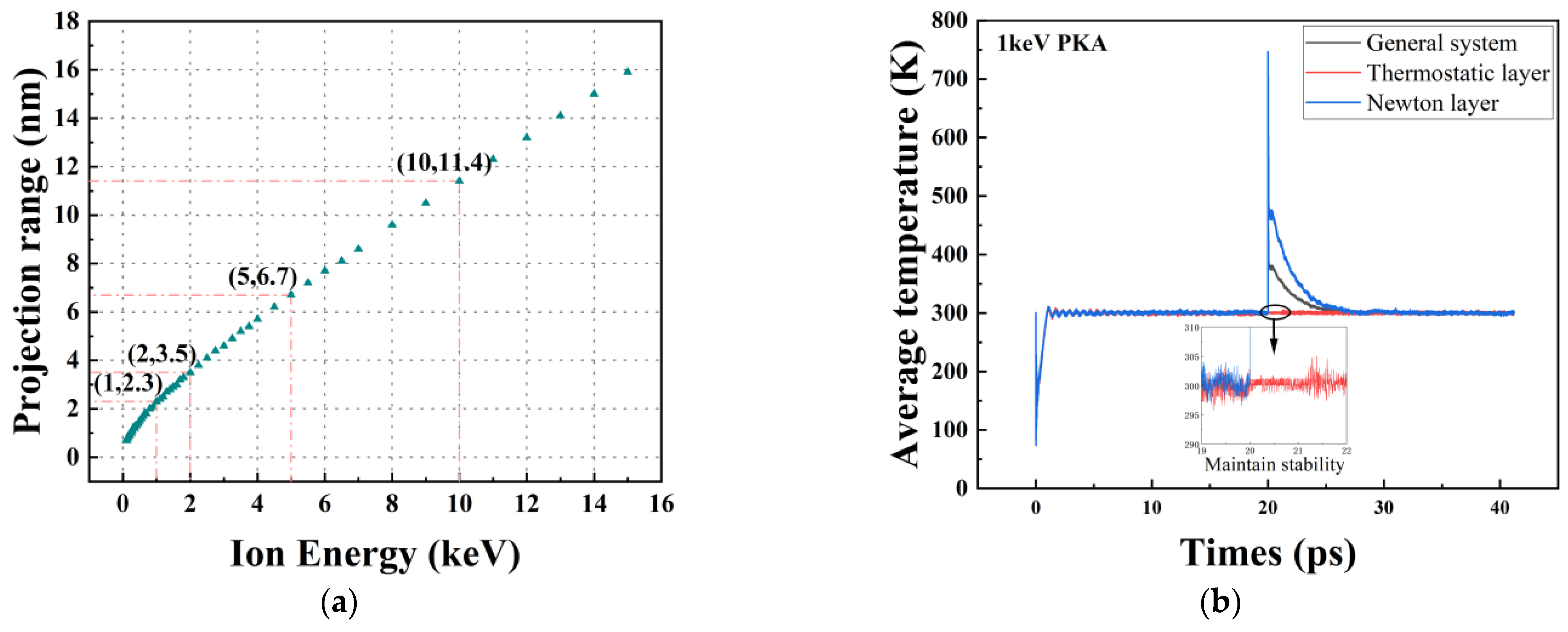
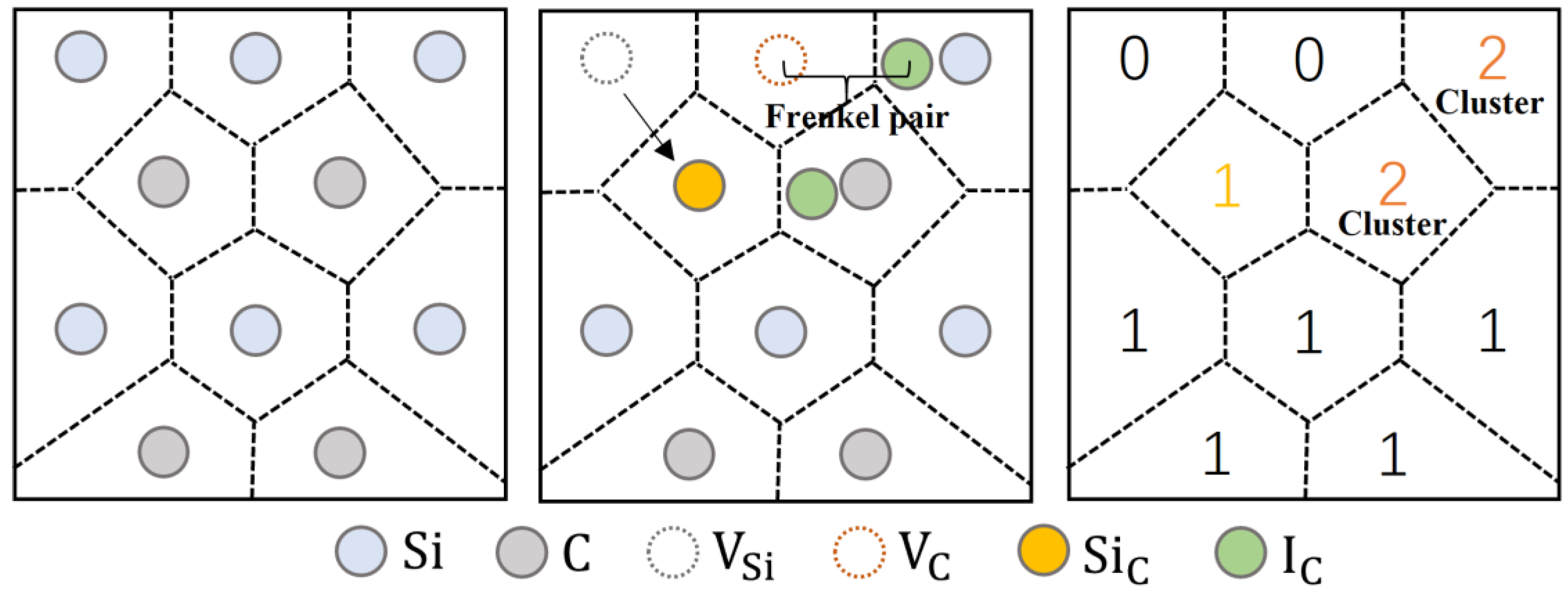
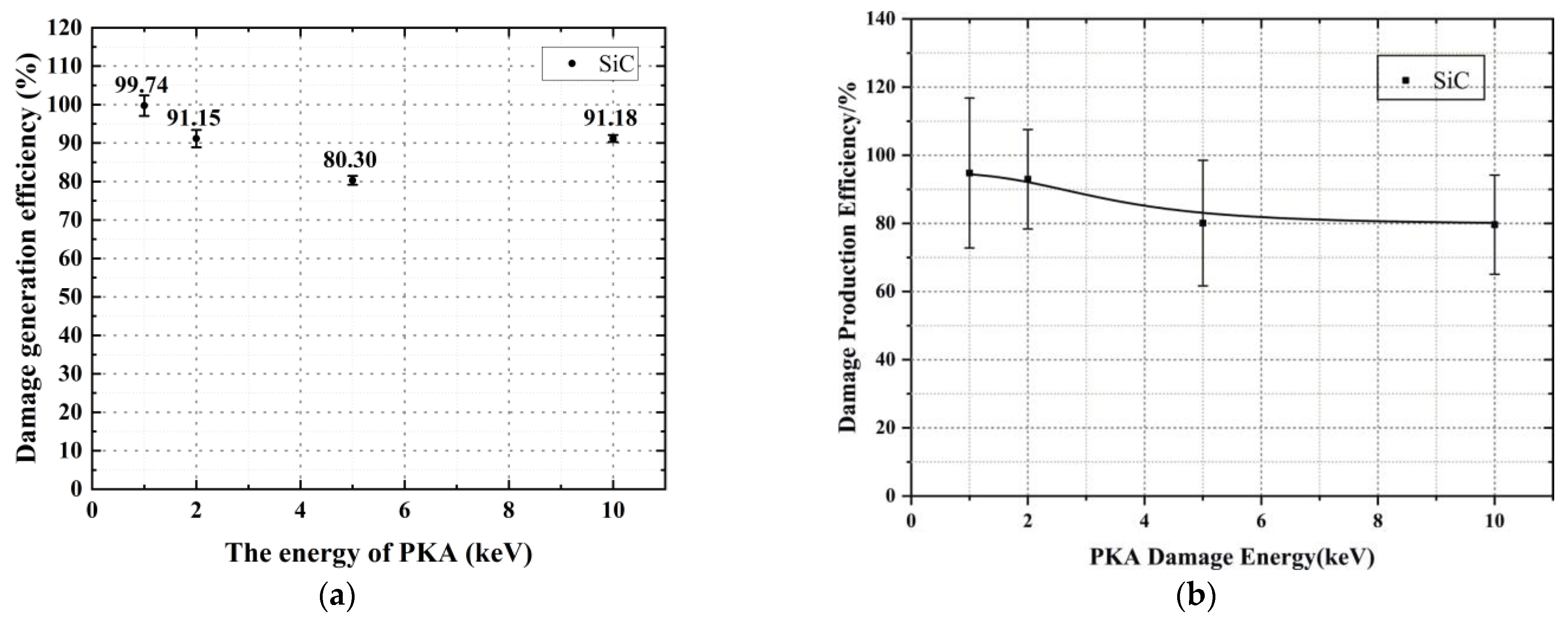
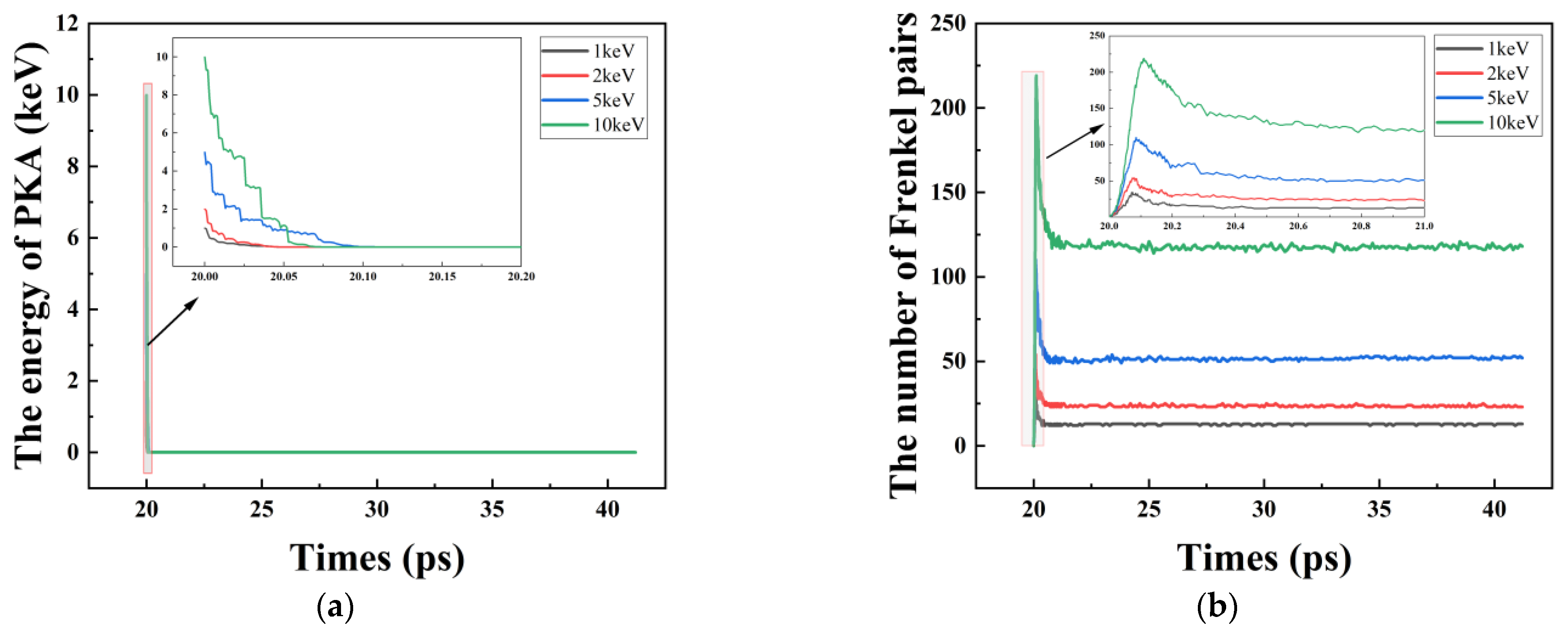
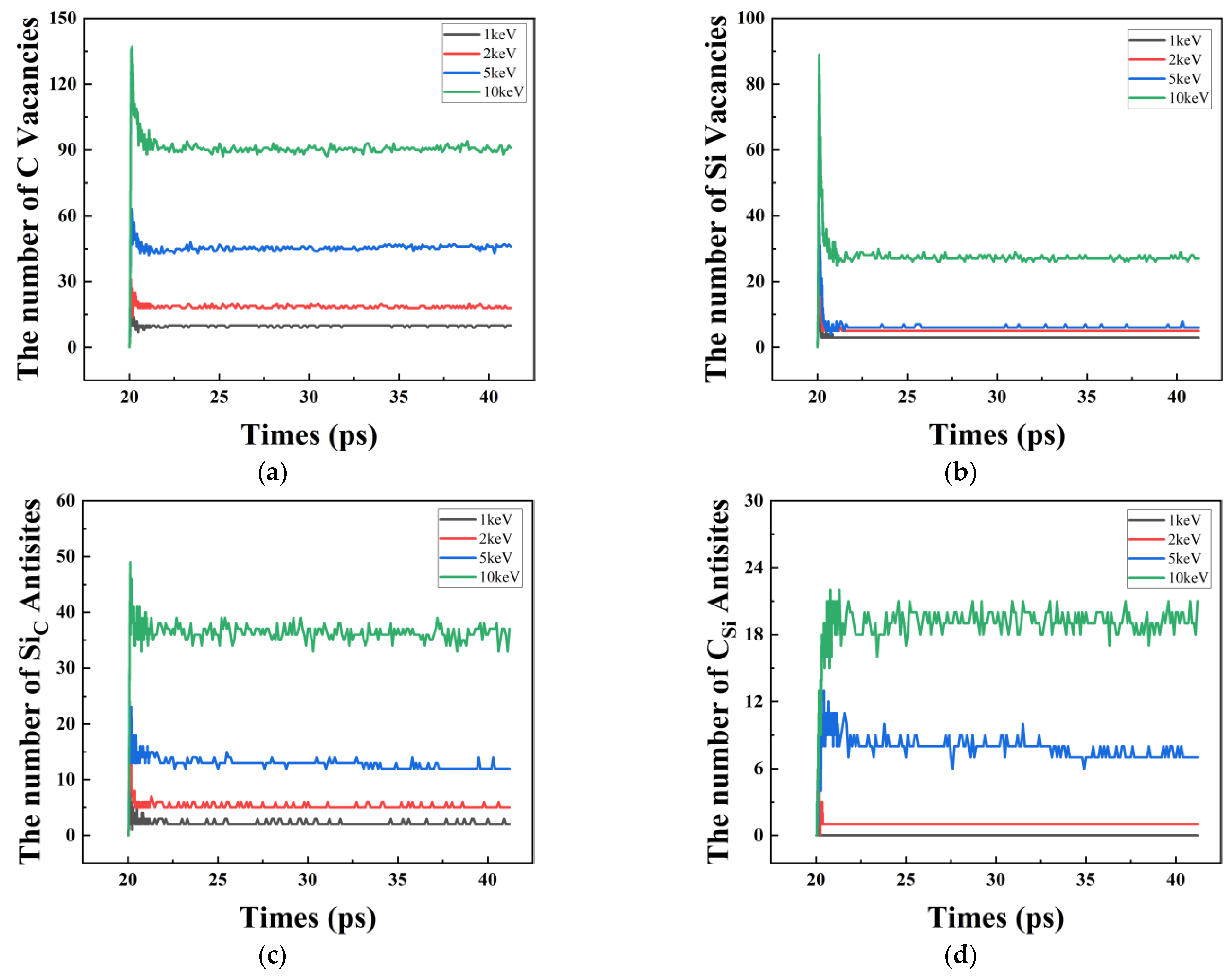
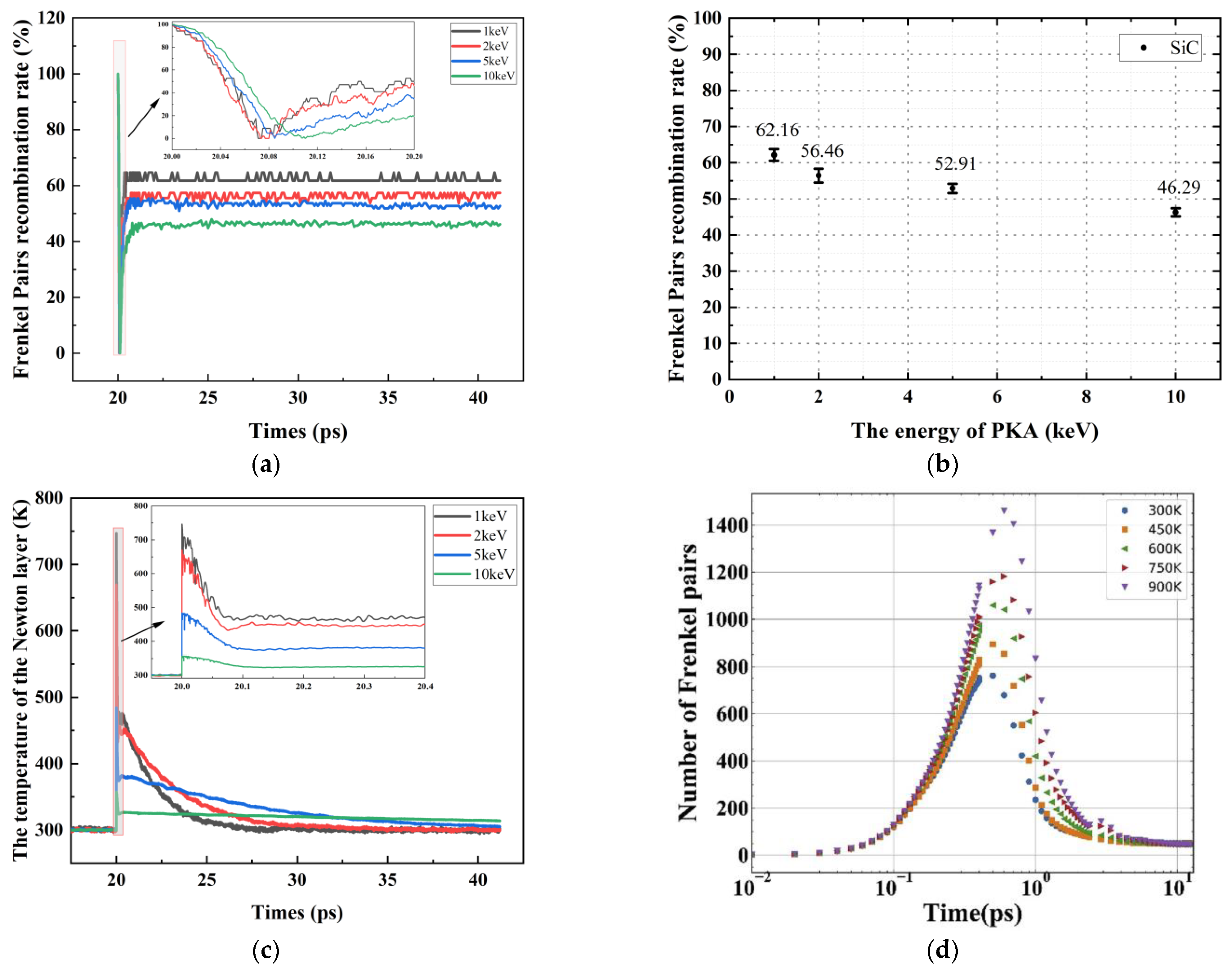

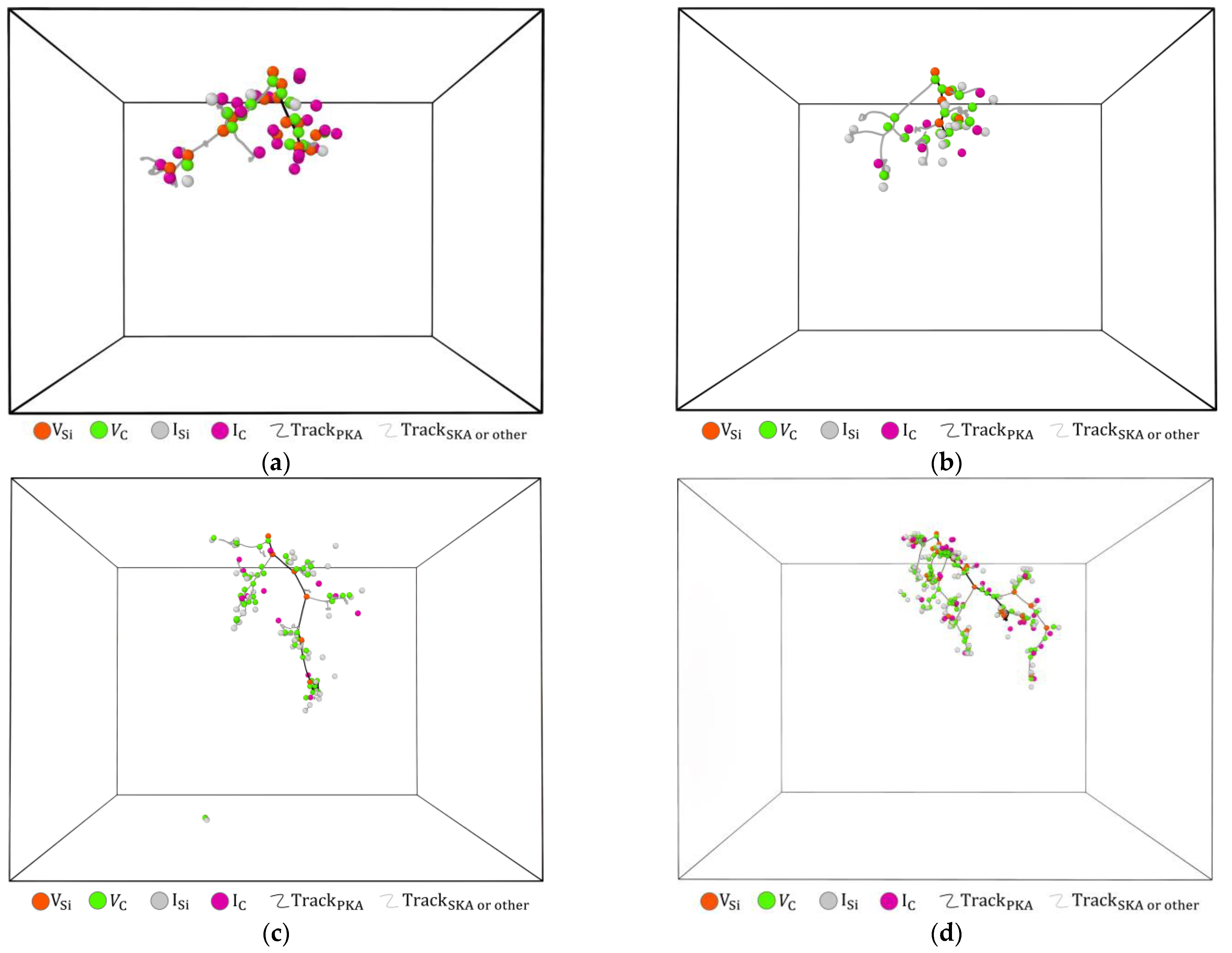
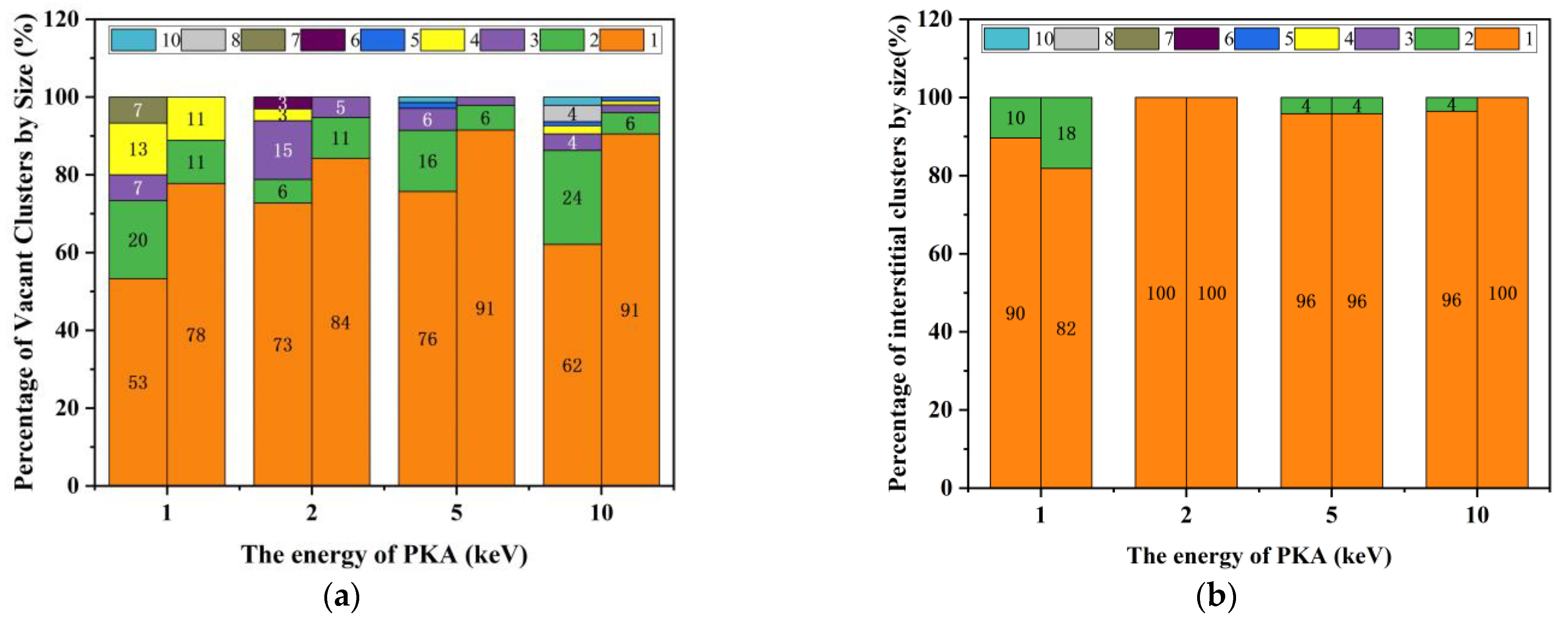
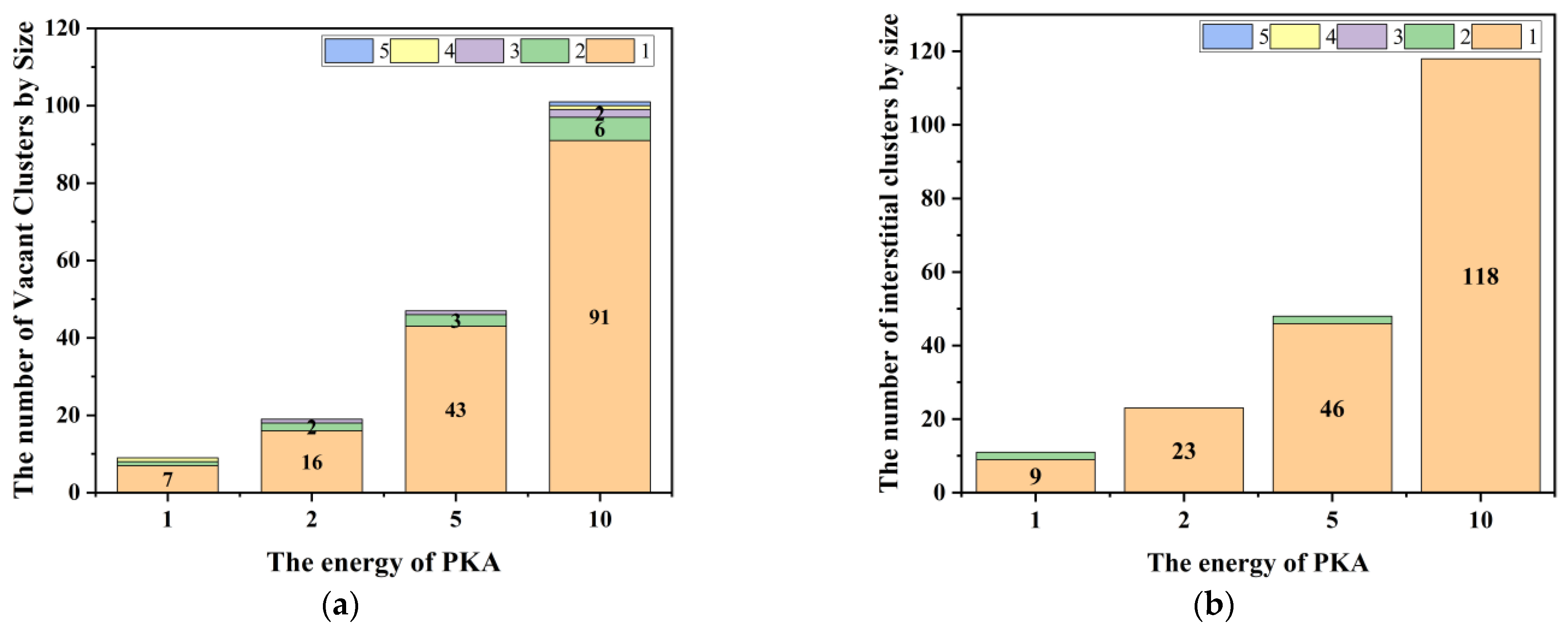
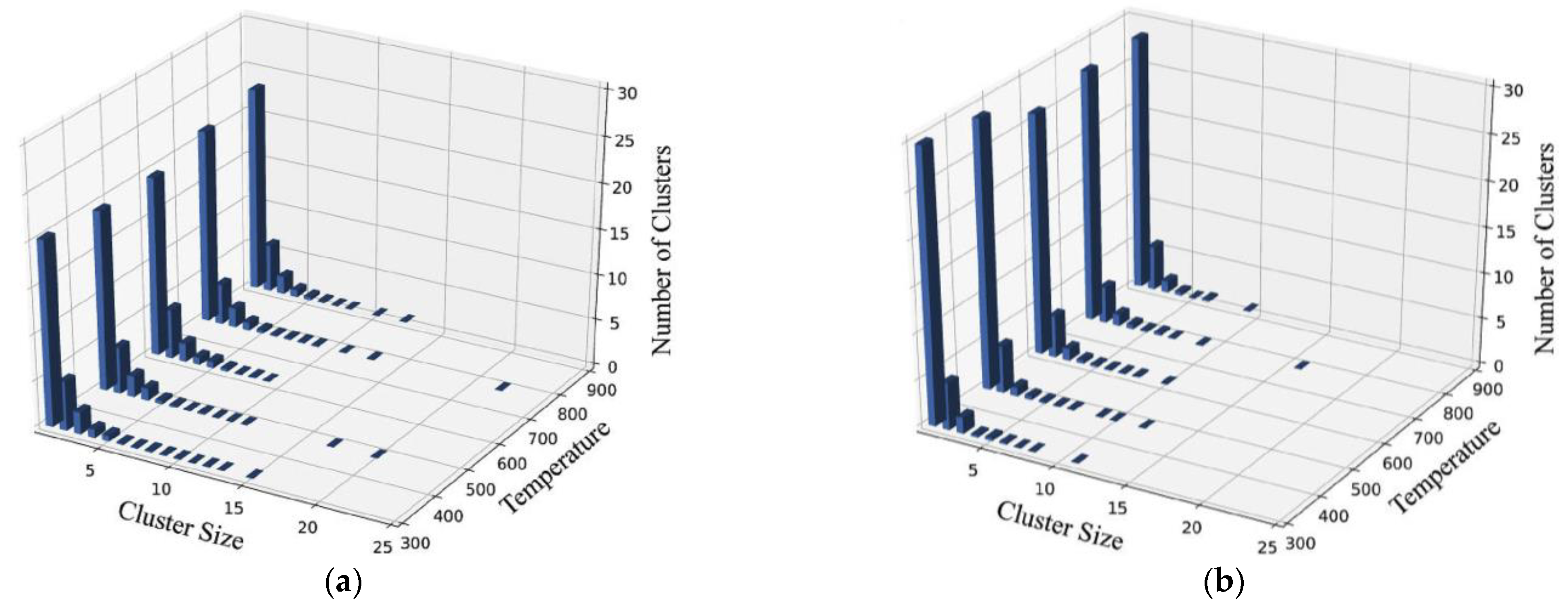
| Material | Energy of PKA | Model Size | Number of Atoms | |
|---|---|---|---|---|
| 6H-SiC * | 1 keV | 37,440 | 829.7398136 | |
| 2 keV | 75,240 | 1173.429298 | ||
| 5 keV | 299,520 | 1852.379976 | ||
| 10 keV | 1,638,336 | 2191.765545 |
| Stage | Time Step | Number of Steps | Times |
|---|---|---|---|
| Relaxation phase | 1 fs | 20,000 steps | 20 ps |
| Cascade collision phase | 0.01 fs | 20,000 steps | 0.2 ps |
| 0.1 fs | 10,000 steps | 1 ps | |
| Steady-state phase | 1 fs | 20,000 steps | 20 ps |
| Item | 6H-SiC | GaN |
|---|---|---|
| Band gap (300K) (eV) | 3.02 | 3.42 |
| Saturation electron transfer rate (cm/s) | 2.0 × 107 | 2.46 × 107 |
| Electron transfer rate (cm2) | 400 | 1000 |
| Thermal conductivity (W·cm−1·K−1) | 4.5 | 2~3 |
| Critical breakdown field strength (MV/cm) | 2.4 | 3.3 |
Disclaimer/Publisher’s Note: The statements, opinions and data contained in all publications are solely those of the individual author(s) and contributor(s) and not of MDPI and/or the editor(s). MDPI and/or the editor(s) disclaim responsibility for any injury to people or property resulting from any ideas, methods, instructions or products referred to in the content. |
© 2023 by the authors. Licensee MDPI, Basel, Switzerland. This article is an open access article distributed under the terms and conditions of the Creative Commons Attribution (CC BY) license (https://creativecommons.org/licenses/by/4.0/).
Share and Cite
Chen, Y.; Liu, H.; Gao, T.; Wei, H. Simulation of the Irradiation Cascade Effect of 6H-SiC Based on Molecular Dynamics Principles. Micromachines 2023, 14, 455. https://doi.org/10.3390/mi14020455
Chen Y, Liu H, Gao T, Wei H. Simulation of the Irradiation Cascade Effect of 6H-SiC Based on Molecular Dynamics Principles. Micromachines. 2023; 14(2):455. https://doi.org/10.3390/mi14020455
Chicago/Turabian StyleChen, Yaolin, Hongxia Liu, Tianzhi Gao, and Hao Wei. 2023. "Simulation of the Irradiation Cascade Effect of 6H-SiC Based on Molecular Dynamics Principles" Micromachines 14, no. 2: 455. https://doi.org/10.3390/mi14020455
APA StyleChen, Y., Liu, H., Gao, T., & Wei, H. (2023). Simulation of the Irradiation Cascade Effect of 6H-SiC Based on Molecular Dynamics Principles. Micromachines, 14(2), 455. https://doi.org/10.3390/mi14020455








